Paul Klee - "Photograph" (?) -
- Image Copyright © (cf.www.dhm.de/lemo/)

Paul Klee - "1914" - (1914)
- Image Copyright ©
(cf. SHB ArtWeb Gallery)

Paul Klee - "On a Motif from Hamamet" - (1914)
Tempera on board - Kunstmuseum Basel, Basel,
Switzerland - Image Copyright © (cf. Olga's Gallery)

Paul Klee - "Hermitage" - (1918) - Watercolor on
chalk ground - Paul Klee Foundation, Kunstmuseum,
Bern, Switzerland - Image Copyright © (cf. Olga's Gallery)

Paul Klee - "Once Emerged from the Gray- of Night" -
(1918) - Watercolor on paper mounted on
cardboard - Paul Klee Foundation, Kunstmuseum,
Bern, Switzerland - Image Copyright ©
(cf. cgfa.sunsite.dk/klee/p-klee6.htm)

Paul Klee - "Station L 112" - (1918)
Watercolor on paper mounted on
cardboard - Paul Klee Foundation, Kunstmuseum,
Bern, Switzerland - Image Copyright ©
(cf. cgfa.sunsite.dk/klee/p-klee6.htm)

Paul Klee - "Cosmic composition" - (1919)
- Image Copyright ©
(cf. www.arts-studio.com)

Paul Klee - "Nocturnal Festivity" - (1921)
Oil on board - The Solomon R. Guggebheim
Museum, New York, NY, USA - Image
Copyright © (cf. Olga's Gallery)

Paul Klee - "A Young Lady's Adventure" - (1921)
Watercolor - Tate Gallery, London, UK
Image Copyright © (cf. Olga's Gallery)

Paul Klee - "Crystal Gradation" - (1921)
Watercolor - Kunstmuseum Basel, Basel, Switzerland
Image Copyright © (cf. Olga's Gallery)

Paul Klee - "Revolving House" - (1921)
Oil on cotton cloth - Thyssen-Bornemisza
Collection, Madrid, Spain
Image Copyright © (cf. Olga's Gallery)

Paul Klee - "Red Ballon" - (1922)
Oil on muslin primed with chalk -
The Solomon R. Guggebheim
Museum, New York, NY, USA - Image
Copyright © (cf. Olga's Gallery)

Paul Klee - "Senecio" - (1922) - Oil on gauze
- Kunstmuseum Basel, Basel, Switzerland
Image Copyright © (cf. SHB ArtWeb Gallery:
www.sackville.ednet.ns.ca/art/)

Paul Klee - "Tale à la Hoffmann" - (1921)
Watercolor on paper mounted on cardboard
Metropolotan Museum of Art, New York, USA
Image Copyright © (cf. cgfa.sunsite.dk/klee/)

Paul Klee - "Mural from the Temple of Longing" -
(1922) - Watercolor, printer's ink and
plastered canvas mounted on cardboard
Metropolotan Museum of Art, New York, USA
Image Copyright © (cf. cgfa.sunsite.dk/klee/)

Paul Klee - "Puppet Theater" - (1923)
Watercolor on chalk ground
Paul Klee Foundation, Kunstmuseum,
Bern, Switzerland - Image Copyright © (cf. Olga's Gallery: www.abcgallery.com/K/klee/)

Paul Klee - "Chinese Porcelain" - (1923)
Watercolor on plaster slab
Collection Mr. and Mrs. Werner Moser,
Zürich, Switzerland - Image Copyright © (cf. SHS ArtWeb Gallery - Exhibit Abstraction)

Paul Klee - "17 Astray" - (1923)
Watercolor and India Ink on paper
mounted on cardboard - Kunstmuseum
öffentliche Kunstsammlung, Basel,
Switzerland - Image Copyright © (cf. cgfa.sunsite.dk/klee/)

Paul Klee - "Carnival in the Mountains" - (1924)
Watercolor on paper on board
Paul Klee Foundation, Kunstmuseum,
Bern, Switzerland - Image Copyright ©
(cf. Olga's Gallery: www.abcgallery.com/K/klee/)

Paul Klee - "Botanical Theater" - (1924-34)
Oil and watercolor on board
Private collection - Image Copyright ©
(cf. Olga's Gallery)

Paul Klee - "Fish Magic" - (1925)
Oil and watercolor varnished
The Philadelphia Museum of Art,
Philadelphia, PA, USA
Image Copyright © (cf. Olga's Gallery)

Paul Klee - "The Golden Fish" - (1925)
Oil and watercolor on paper, mounted on
cardboard - Kunsthalle, Hamburg, Germany
Image Copyright © (cf. SHS ArtWeb Gallery
Abstraction and Formalism: Paul Klee)

Paul Klee - "The Mask with the Little Flag" - (1925)
Watercolor on paper mounted on
cardboard - Staatsgalerie, Munich, Germany
Image Copyright © (cf. CGFA: cgfa.sunsite.dk/klee/)

Paul Klee - "Gate in the Garden" - (1926)
Oil on panel - Huggler Foundation
Kunstmuseum, Bern, Switzerland - Image
Copyright © (cf. Olga's Gallery)

Paul Klee - "Reconstruction" - (1926)
Oil on muslin - Kunstsammlung
Nordrhein-Westfalen, Düsseldorf, Germany
Image Copyright © (cf. Olga's Gallery)

Paul Klee - "Around the Fish" - (1926)
Tempera and oil - The Museum of Modern
Arts, New York, NY, USA - Image
Copyright © (cf. Olga's Gallery)

Paul Klee - "Attrapen (Omega 5)" - (1927)
Oil and watercolor on cardboard -
Thyssen-Bornemisza Collection, Madrid,
Spain - Image Copyright © (cf. Olga's Gallery)

Paul Klee - "Flora on Sand" - (1927)
Watercolor on paper - Collection Felix Klee, Bern,
Switzerland - Image Copyright © (cf. SHS ArtWeb Gallery)

Paul Klee - "Little Jester in a Trance" - (1929)
Oil and watercolor on hessian - Museum Ludwig,
Cologne, Germany - Image Copyright © (cf. Olga's Gallery)

.jpg) Conrad Botha Generalism
Conrad Botha Generalism.jpg) Conrad Botha Generalism
Conrad Botha Generalism.jpg)





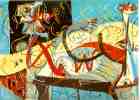
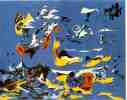
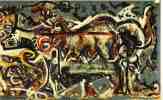

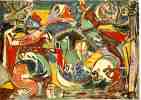


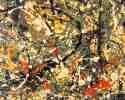

.jpg)
.jpg)
.jpg)




























